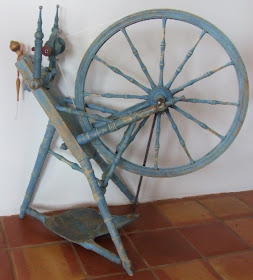


This is a pretty amazing job of resurrecting a spinning wheel. Fred outdid himself this time. This wheel came to us missing its front leg, one stretcher, both maidens and bobbin and flyer.
It was pretty tricky to get the leg stretcher fitted into the existing hole in the crossbar between the two back legs and into the front leg. Fred only had some photocopies of similar wheels from Vesterheim to go by along with online photos from the Norsk Folke Museum.
It was pretty tricky to get the leg stretcher fitted into the existing hole in the crossbar between the two back legs and into the front leg. Fred only had some photocopies of similar wheels from Vesterheim to go by along with online photos from the Norsk Folke Museum.
The Norsk Folke Museum spinning wheel collections are online here. Use rokk as the search term. The photos were pretty small so details on the maidens had to be for the most part imagined.
The wheel belongs to the group of Norwegian wheels I call “steep slanted table” types in an article here.
This wheel has a 24” drive wheel with a whorl with two ratios. One is 1: 16 and the other is 1: 14.75. It is extremely light weight.
The wheel is loaded with decorative details. There are pretty cut outs on the table; turned ends on the bottom of the wheels supports, a hand forged wrought iron footman with a curlicue at the end of its hook over the axle cam. Instead of having an external crank for the footman, the axle crank is between one side of the wheel and the wheel support.
I painted the new parts of the wheel so they would be a close match in color to the rest of the wheel, but am not sure whether to keep the “shabby chic” look or ad more paint to cover the bare spots.
The wheel belongs to the group of Norwegian wheels I call “steep slanted table” types in an article here.
This wheel has a 24” drive wheel with a whorl with two ratios. One is 1: 16 and the other is 1: 14.75. It is extremely light weight.
The wheel is loaded with decorative details. There are pretty cut outs on the table; turned ends on the bottom of the wheels supports, a hand forged wrought iron footman with a curlicue at the end of its hook over the axle cam. Instead of having an external crank for the footman, the axle crank is between one side of the wheel and the wheel support.
I painted the new parts of the wheel so they would be a close match in color to the rest of the wheel, but am not sure whether to keep the “shabby chic” look or ad more paint to cover the bare spots.
Your wheel is beautiful, I have one something like it.
ReplyDeleteThat wheel is beautiful. I would leave as is. Now I am off to check out the museum. Freds a Keeper.
ReplyDeleteGreat job of restoring that wheel, it is beautiful! Fred is an artist!
ReplyDeleteThe details are really something-
When you sit down to spin on it, I bet you spend a few moments just admiring the lines ;-)
For what it's worth, I love the "shabby chic"--it adds to the charm!
Ooooh la la!
ReplyDeleteWhat a beauty. I love the patina of age.